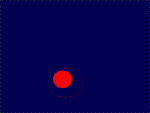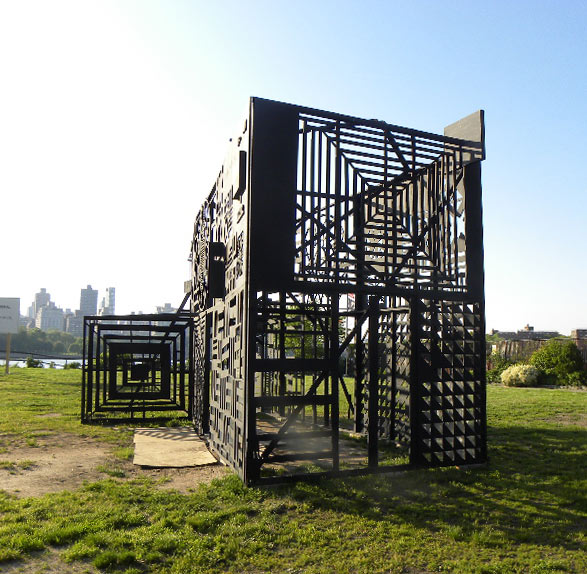
A State Fair In Queens
Socrates Sculpture Park Goes To The Country
by Gordon Fitch
Note: each image below is linked to a larger
version which can be viewed by clicking on
the small one.
Queens is reputed to have something like 157
different ethnic groups, each with its own
language and culture. Perhaps almost as remote
from the common experience of most of the locals in
Astoria and Long Island City as the marches of
Uzbekistan (except for our Uzbek contingent)
this summer's Current Exhibition,
"State Fair", was themed on the eponymous public
events of America's rural areas. Artists were
invited to connect the historic state fair of
traditional rural America with the polymorphous
21st-century physical reality of urban Queens,
within sight of the tallest of Manhattan's tall,
glittering towers, and indeed in the literal
glitzy shadow of advancing gentrification.
The curator of this exhibition did not intend
a crowded, noisy state fair atmosphere, so the
results, while popular enough, were somewhat
less frantic than the Platonic form of the
state fair, but fit in very well with the park's
neighborly, congenial atmosphere. The resultant
works were diverse and surprising: above, you see
one of them, a "barn" devised by Bernard Williams.
But there is more, much, much more.
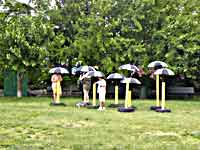
|
|
Risa Puno: "The Big Apple Showdown" (detail)
|
Contemporary art, at least the contemporary art
which is acknowledged and supported by the
institutions in my vicinity, continues to be
strongly weighted towards Conceptualism, although
(as I shall relate) I did see some looks backward
(or forward) to the more austere formalities of
now so-unmodern Modernism. I will begin,
however, with the first thing I came across:
rolling umbrellas attempting to escape from Risa
Puno's "The Big Apple Showdown", which constitutes
a kind of interactive game or contest in the form
of an obstacle course, but based on urban rather
than rural obstacles, the errant umbrella being
one of several reminiscent of midtown Manhattan on
a rainy day. Other objects which had to be dodged
or passed through included subway doors, a pathway
leading to a stop sight, and a brownstone stoop
without the brownstone. I seized the umbrella and
attempted to return it to what seemed to be its
home, and thus got to meet the artist personally,
who was getting the others under control.
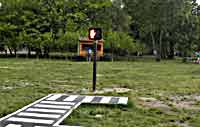
|
|
Risa Puno: "The Big Apple Showdown" (detail)
|
As a long-time traverser of Manhattans oft
umbrella-laden canyons, I thought the whole
business of flying umbrellas was pretty realistic,
but I don't think it was supposed to work that
way. Unfortunately I was not present to see
actual contestants contesting, but in any case the
trials of the poor commuter are a little bit too
close to home for my unalloyed delectation. I
believe many of the visitors were less cranky
than I, however.
Some of the artist's other works can be seen on
http://www.risapuno.com
which comes at you with an interesting, very short
musical composition of the electronic sort, so
turn your sound on if you visit.
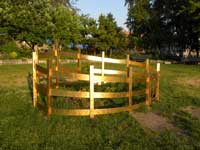
|
|
Jeanine Oleson: "Retribution"
|
Near the The Big Apple Showdown was a smaller
work named "Retribution", by Jeanine Oleson. This
is a sort of mini-corral painted gold; inside it
are a number of flowering herbs. The work by
itself is pretty but it requires the knowledge
that it represents the myth of the unicorn to
achieve a conceptual dimension. Or, as the program
says, "This structure is a monument to the unicorn
and the maiden able to tame it;
there by highlighting the power of the female. The
installation will also function as a garden of herbs
known for their restorative properties, which
visitors are invited to harvest for their own
use." The idea of the corral, though, might have
another meaning for the unicorn.

|
|
Margarita Cabrera: "Arbol de la Vida -- John Deere"
|
Heading west from the corral, I encountered another
corral, this one encircling a tractor painted pink
tending toward lavendar, and covered with small
sculptures of flowers and birds. The tractor is the
real thing; the sculpture is built around the body of
a regular tractor. There is quite a span of connections
here. The Tree of Life is one of the most persistent
symbols in mythology, popping up not only in Mesoamerica,
including pre-Columbian Mexico, but in Norse mythology (Yggdrasil) and
the Kabbalah as well. At the same time, it has become an occasion of
folk art and the related kitsch. This particular work does not make
strong claims on these connections; it's rather delicate, and we're told
that the artist intended mostly to remind us of the contribution of
Mexicans to our agriculture, and perhaps their reduction as well.
(But one thinks of the conversos heading to Mexico to avoid
the Spanish Inquisition -- were there Kabbalists among them?)
For more views of this artist's work see
http://www.margaritacabrera.com

|
|
Dana Sherwood & The Black Forrest Fancies:
"The Ladies Society of Alchemical Agriculture"
|
Heading yet further west, and continuing in the Hermetic
tradition, I came to "The Ladies' Society of Alchemical
Agriculture" by Dana Sherwood and the Black Forrest Fancies.
As you can see from the picture, it's a combination of a
wagon and a shed, and within it are numerous small mysterious
objects including some that are interactive -- they move
when an exterior handle is turned. I cannot outdo the
State Fair's program in describing
the interior: "On display inside the wagon are a
number of living terrariums, full of natural and
cultural materials collected from around the
Americas that have been selected on the basis of
their purported desirability.
These materials
include local epicurean delights, urban detritus
and the distinct self-contained ecosystems that
propagate around these. Also on view are a series
of clockwork automata of biological anomalies
and artificial confections in varying stages of
mutation and putrefaction."
I could not help but be reminded by this structure
and its contents of Joseph Cornell's boxes, made
only a few miles away in Queens,
which with me is high praise indeed,
but the artists claimed no direct kinship with
the 20th-century master. Yet perhaps the World
Spirit wafted over from Utopia Parkway....
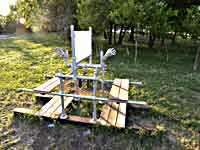
|
|
William Stone: "Remote Arm Wrestle"
|
Not far away from the alchemical wagon was
William Stone's arm-wrestling machine, a sort of
"visual pun" which allows two participants to
arm-wrestle one another without having to touch
or see each other. Should an opposite particpant
be unavailable, the arms are weighted with an
easily-defeated weight hidden below. It occurred to me that
the artist might also have gratified victorious
solo narcissists,
and perhaps doubled the pun, had he
affixed mirrors to the screen which blocks the
views of the wrestlers.
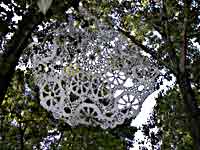
|
|
Jennifer Cecere: "Mom"'
|
Spookily up in a tree just behind the arm-wrestling
machine, and coming suddenly out of hiding as one
walks toward it, was an enormous doily, the work of
Jennifer Cecere, who made it of acrylic and rip-stop
nylon. It is about 20 feet across along is major
axis, and moves about impressively as the wind
goes through the trees. Originally, the artist said,
she had had the idea of throwing over the entrance
gate of the park, but I think the trees were a better
choice. It is hard to convey the impression of the
work without making a movie. This, one might say,
is some mother. The artist also envisions similar
works strung between office buildings, which would
relate in quite a different way to their environment.
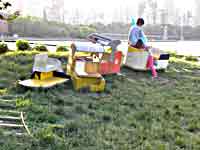
|
|
Emily Feinstein: "The Ride"
|
Passing northward, one encounters Emily Feinstein's
"The Ride", a set of non-functional cars for a
non-existent amusement park ride, often a major
feature of state fairs. By themselves (I came by
more than once) they do seem sadly nostalgic, but
once the park was populated by its usual staff
of small children and dogs, the nostalgia was ignored
and the cars climbed on and "ridden" with happy
abandon. One never knows what uses the future
will make of the past!
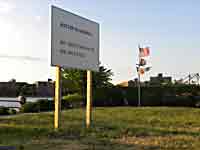
|
|
Charles Gute: "More Matter In General"
|
Next to this is Charles Gute's "More Matter In General".
To understand this work, you need to know that state
fairs in some regions offer such delicacies as deep-fried
pickles, deep-fried plums, deep-fried Mars Bars -- deep-fried
anything, in fact, on a stick. One can, then, easily extend the
concept of deep-frying things on a stick to a tree or a building. As one
contemplates this sign, one sees the Flag, the East
River, Roosevelt Island.... enough said.

|
|
Bernard Williams: "Socrates Ply-Teck Barn"
|
The most imposing work of the collection was at the
north end of the park: this was Bernard Williams
"Socrates Ply-Teck Barn". Ply-Teck is a kind of
plywood: someone gave a lot of it to Socrates Sculpture
Park, and the artist was unleashed upon it. The
building, for that is what it is, is 16 feet high
and 32 feet long. It is painted black. Although it
is made of wood, spaces have been left between the
components which give the structure as a whole a
translucent, airy quality. Large apertures allow
viewers to walk inside and through the sculpture.
For me, the overall shape was more
reminiscent of a ship than a barn. The surfaces
were inscribed with designs alluding to quilts,
hex signs, highway signs, and cultural institutions
related to rural life, like Yazoo (among other
things, the name of a record company famous for
Delta blues).
In looking at this work, I could not help but be
reminded of Louise Nevelson's large works, often
similarly imposing and made of wood painted black
in components actual derived from the detritus of
broken furniture or reminiscent of it.
(Think of
"Sky Cathedral" or
"Mrs. N.'s Palace".)
I don't know if the artist would care to draw
this connection; the park's program doesn't
mention Nevelson. It is interesting, though, to
see Modernism creeping back, even if it's
standing quietly in the shadows.
(I probably missed a few participants here; some of
the work is performance art for which I didn't happen
to be present, and some may have been away visiting.
Should the artists contact me to complain, I'll
append mention.)
Overall, Socrates presented a considerable artistic
experience of very contemporary material, sometimes
playful, sometimes serious work among the relaxed atmosphere
and casual acceptance with which the neighborhood
treats the park and the park treats the neighborhood.
May it be ever so.
The show is on now and will continue until September.
Some useful links:
 Socrates Scupture Park State Fair
Socrates Scupture Park State Fair
 Exhibition Press Release and Checklist (PDF)
Exhibition Press Release and Checklist (PDF)
|
